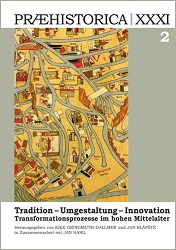Südlich der Alpen; Ein Blick auf den mittelalterlichen Landesausbau im Friaul/Nordostitalien
To the South of the Alps – A Look at the Medieval Land Development in Friuli/Northeast Italy
Author(s): Holger GrönwaldSubject(s): Social history, Social development, Rural and urban sociology, 6th to 12th Centuries, 13th to 14th Centuries, 15th Century, 16th Century
Published by: Univerzita Karlova v Praze, Nakladatelství Karolinum
Keywords: Middle Age settlement colonisation; friulanian land history; Friuli; Friuli; Venzia-Giulia; march of Verona; Holy Roman Empire; northern Italy; Slavic settlement; German settlement;
Summary/Abstract: The article examines medieval regional development in Friaul (Friuli – Venezia-Giulia/north-east Italy). It offers an overview of the basic rural and urban settlements between 8th and 16th centuries. As difficult as it can be to describe the complex historical events, little effort has been made to incorporate archaeological perspectives. Up until now most of the attention in Friaul has been drawn to the main fortification and its numerous towers. Given that the structural changes have rarely been thematised, our attention should now be steered toward these monuments and their huge research potential with the aim of including Friaul as part of the Holy Roman Empire in current studies of High Middle Age land development [Landesausbau]. This sketch of the local history [Landesgeschichte] asks questions of the hitherto roles of archaeology and historical science. The Friulanian historical time-line introduced in the article concurs broadly with historical-juridical traditions. However, only a small amount of the archaeological inventory has been investigated in support of this. This leaves open the possibility for further research to close up any gaps in the historical tradition and to check hypotheses, such as possible connexions with local place names. Place names are generally good descriptive indicators of settlement characteristics and of those involved in regional development. Each and every place name should always be carefully researched. That said, both the German place names, which appear in a small chronological window, and the now indubitably established Slavic place names (reputedly early signs Karantanian rule from the end of 11th century) illustrate mediaeval trading routes and carriageways. Current historical sources presume planned settlement development as commissioned by the given hierarchical power. The newer additions to the main fortification however, would appear to challenge these assumptions. No longer subject to the geo-political sensibilities of the previous 2 centuries, this article gives life to the image of a multi-ethnic colouring to historical regional land development.
Journal: Praehistorica
- Issue Year: 31/2013
- Issue No: 2
- Page Range: 269-290
- Page Count: 22
- Language: German

